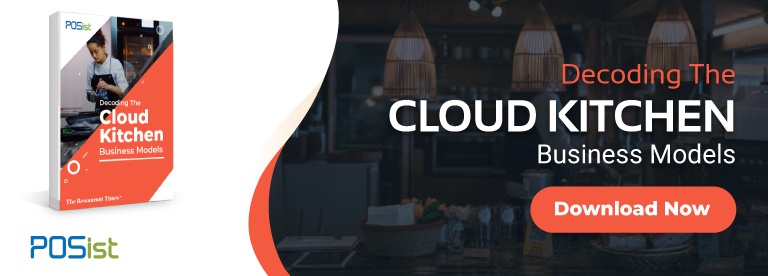The demand for online food delivery has gained immense popularity in the last few years. According to the reports, the global Cloud Kitchen Market size is estimated to reach USD 71.4 Billion by 2027, with a CAGR of 12.0% from 2021 to 2027. This increasing demand for food delivery, high overheads, and thinning margins, coupled with the stiff competition in the restaurant space has led to restaurant operators shutting down the storefront altogether and open the more economically profitable, cloud kitchens. A cloud kitchen is a delivery-only restaurant, with no dine-in facility. Cloud kitchens are also known as dark kitchens, ghost kitchens, virtual restaurants, and satellite kitchens. Since the primary source of order-taking is through the internet, or cloud as they call it, and there is no physical storefront for the customers, these delivery-only restaurants are called cloud kitchens.
Why Cloud Kitchens Have Gained Popularity
Over the years, cloud kitchens have emerged as the popular investment choice for both established as well as new restaurateurs for opening a food business. Faasos by the Rebel Foods, Biryani By Kilo, Freshmenu, are some of the popular cloud kitchen chains operating in this segment. Established restaurant chains are now also opening cloud kitchen outlets instead of opening a dine-in outlet to cater to high food delivery orders.
Online food aggregators, which are the major enablers in this segment have also tried their hands in the cloud kitchen business. Food ordering and delivery app Swiggy launched shared cloud kitchen spaces called Swiggy Access and enabled new as well as existing restaurants to operate delivery-only operations from these kitchen spaces.
Let us understand why the entire F&B industry is jumping onto the cloud kitchen bandwagon.
1. Market Opportunity
The ease of getting food delivered at a reasonable price and in record time has led to an increase in the number of orders being placed online. Instead of dining out, people are preferring to order in. Online food delivery is not only eating into the market share of traditional dine-in restaurants but is also replacing home-cooking.
Because of the shift in customer preference and an increased sense of hassle in dining out, the home delivery option has gained momentum and along with that has brought a change in the restaurant industry as now food overpowers the dining experience.
An average urban, working professional orders online 3-4 times a week and this number can go up to ordering daily in certain cases. Online aggregators are also expanding operations in Tier-ii & Tier-iii cities, further increasing the market size.
2. Low Investment
Cloud kitchens require less investment to open since you no longer need a prime location with high footfall, which reduces the real-estate cost. Also, since there is no front-of-the-house, you don’t need fancy interiors and hospitable wait staff to ensure a great guest experience. These two factors play a major role in bringing down the cost of opening a cloud kitchen business. You can open a cloud kitchen at one-third of the investment required to open a traditional dine-in restaurant.
3. Ease In Experimentation
The cloud kitchen business model allows restaurateurs to experiment with multiple concepts without much investment. You can operate multiple brands from a single kitchen by using the same kitchen infrastructure and resources. Opening a new brand is as easy as simply getting the new brand listed on the online food aggregators.
Since the listing is free on the online food aggregators, and they charge a certain percentage per order, you only need to spend on order preparation. In case the brand does not do well, you can simply remove the listing from the online food aggregator. The success or failure of one brand does not impact the other brands operating from the same cloud kitchen in this case.
Read how multi-brand cloud kitchens allow restaurateurs to experiment with more concepts with minimum risks here.
4. Ease In Scaling Operations
Scaling operations is much quicker and simpler in the case of the cloud kitchen business. Since the investment required to open a cloud kitchen is significantly less, you can open more cloud kitchens in the same time period.
Shared cloud kitchen spaces and operator-managed cloud kitchens are playing an integral role in helping cloud kitchen companies achieve scale. These cloud kitchen spaces are already situated in high-demand areas and act as a food production hub by including several brands. A restaurant that is trying to expand the business and enter a new market can simply take space in such shared kitchen spaces and start operations without any hassles.
These shared kitchen spaces come equipped with all the necessary equipment and the required infrastructure. A restaurateur can simply rent this space, bring the necessary raw materials and the staff, and start operations from day 1. The cloud kitchen business model makes scaling operations and expansion in new geographies extremely easy.
Read how shared cloud kitchen spaces are revolutionizing the cloud kitchen business here.
The cloud kitchen business is highly profitable owing to the low overheads. However, the cloud kitchen business also requires high online order volumes for it to be profitable. The profit margin per order is not very high in the case of cloud kitchens, and hence you need to process a high number of orders to make sense of the unit economics. Fortunately, a cloud kitchen can process more orders in the same time period as compared to a traditional dine-in restaurant.




















The article is very comprehensive and well analyzed still very easy to understand. Cloud Kitchens don’t require a lot of upfront costs when compared to a classic dine-in, it provides an opportunity to test out their brand & customer base before opening a premise in a low-risk environment. Good Read. Thank you.
This article is very informative.
Cloud kitchens profits are usually higher than a traditional restaurant. You just have to ensure your delivery is on point and you should be good to go.
All the best for your cloud kitchen endevour.
The Cloud kitchen business model is actually great for first time restaurant owners who dont have a lot of investment for opening a restaurant. Number of online orders is increasing and this is a great way to enter the restaurant business.
Cloud kitchen business in India is on a massive rise. With the low initial investment, this format has evidently become a favorite for most of the aspiring restaurant owners of the country. In such a situation, this article will come in handy since it provides in-depth insights about this format and its high-profit margin.
There is enough room for good , well managed restaurants in spite of cloud kitchens competition .
I have to open a new kitchen so you suggest tell me good
How to start my cloud kitchen in Hyderabad
I want to start cloud kitchen in Delhi
This article is very informative. I have to open a new kitchen so you suggest tell me good
Good artical, it could be much effective
cloud kitchen come in India and massive rise low investment and big profit this articel is very use full to open cloud kitchen
How to start my cloud kitchen in Noida and lucknow?
Informative article.. I had a query?
Does the electricity department provide power @ industry rates as to support the online kitchen concept as the concept doesn’t allow sales or doesn’t have serving arrangements too…
Please share ur views & if any kind of certification required to avail such facilities….
How to start it.. I am interested in it…